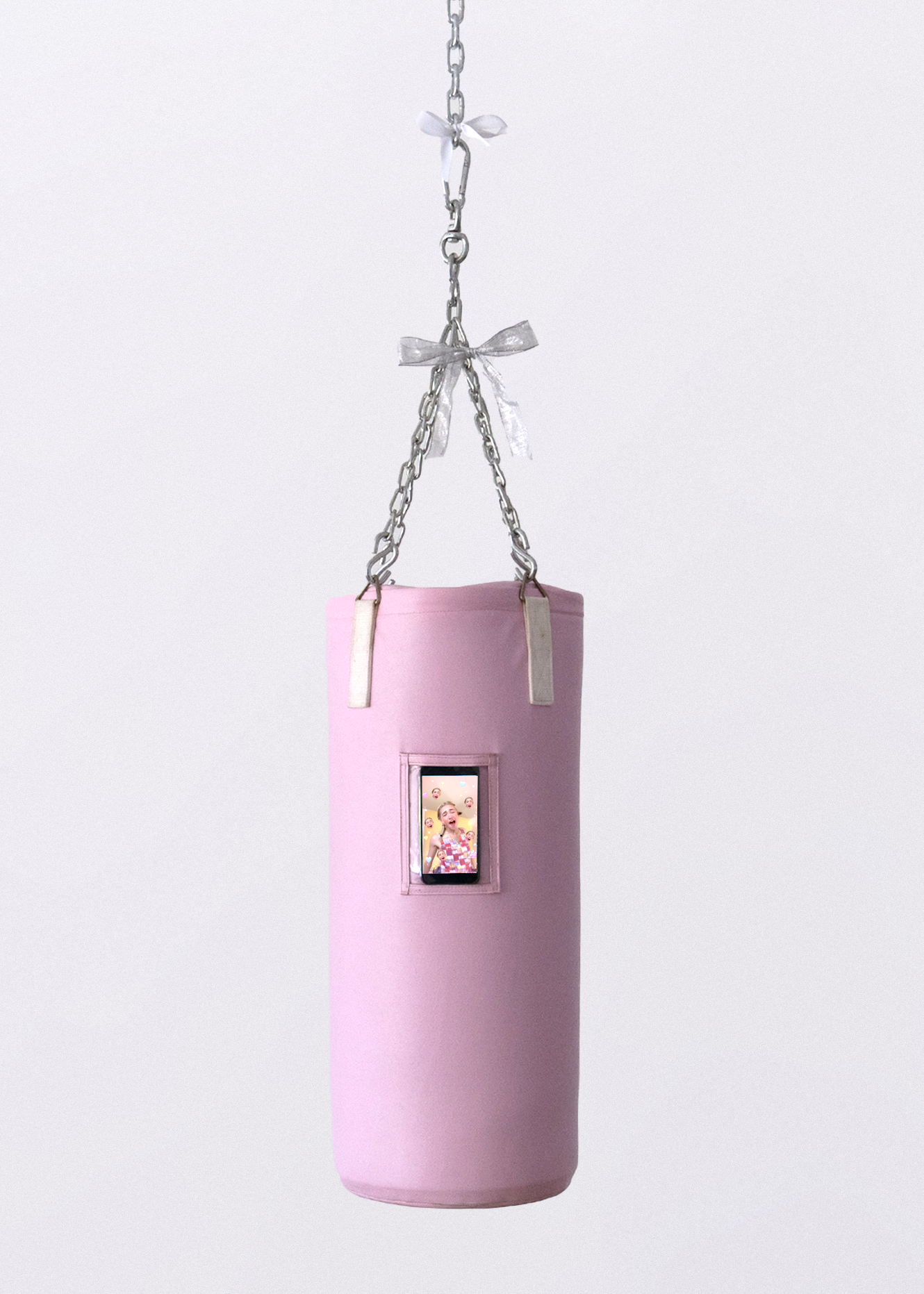+<3+.#’
Scroll As Textile: An Interview with Maya Man
&~~.0_0`
Anabelle Johnston
@(=&!
Maya Man is a multimedia artist who plays with patterns of attention, distraction, work, pleasure, performance, consumption, spontaneity, authenticity.
I am a founding editor of Syntax and superfan.









Of course I was drawn to her work for the obvious reasons: it is often text-based and charming, makes permeable the boundary between art and posting, and regularly contends with the nebulous condition of (digital) girlhood. On a perhaps misguided note, I also resonated with her biography. I, too, hail from suburbia. We both recently graduated: I, from undergrad, and Maya, from the UCLA Design Media Arts MFA program, where she studied with her mentors Casey Reas and Lauren Lee McCarthy, who developed Processing and p5.js, respectively. We both briefly flirted with working in tech, though to varying degrees (I took three undergraduate courses, Maya worked at the Google Creative Lab in New York while collaborating with both the School for Poetic Computation and Soft Surplus—two very cool interdisciplinary collectives that examine(d) the relationship between art, hardware, and code).
As such, when we spoke via Zoom in June 2023 about her recent exhibitions, we got sidetracked into the perils of marketing, being a Girl, claiming our respective Asian identities, and consumption as a form of becoming.
My computer froze and erased approximately ten minutes (non-consecutive) of the interview recording over the course of the two hours Maya graciously sat with me. Text that has been summarized from memory, and/or totally falsified to provide a transition that seemed about right, appears in yellow highlights below. All this to say, this interview has been edited for concision and clarity. 😎
#girlhood, #performance, #skincare, #gossip, #quilt, #influencer, #digital, #gaze, #posting, #modelminority, #online, #GlanceBack, #reading, #glitch, #generativeart, #capital, #brainworms~ Anabelle Johnston
 https://mayaontheinter.net
https://mayaontheinter.net
Anabelle Johnston: Okay cool. I recently got booted from my school Zoom so we have a 40 minute time limit —
Maya Man: Oof.
AJ: If we have to go over we can start a new one… But losing that and Adobe, I was like, wow, you guys are really just kicking me out into the curb.
MM:I know, I'm about to lose Adobe also and I’m really sad. It's rough. I actually haven't even looked how much it would cost, I'm so scared. And congrats on graduating.
AJ: Thank you. Congrats on graduating!
MM: Thank you! Do you live in New York now?
AJ: Sort of. I grew up outside of the city, and right now I'm house hopping until I actually get a place, which involves a lot of family dinners with friends’ parents and some air mattressing.
MM: Oh, cool. Fun!
AJ: I’m kind of all over the place, and characteristically, my questions will be all over the place just because I love a lot of your work and there was no one particular thing I wanted to address. I suppose I’ll start with Instagram… Online (#digital), the boundary between art and “content” is obviously blurred. I accidentally spent like 30 minutes just going through your Instagram right before this—
MM: (Laughs, AJ hopes)
AJ: And I was looking at those recent videos you posted with that funky filter and semi-ironic music, like *7157463053032885547 (stream of consciousness)* or your incredible series with the computer science textbooks. The humor, to me, comes from conversation between these works and the thousands of Facebook posts that take up this aesthetic seriously, creating a metacommentary on the form. It’s posting, but as an art practice. For you, how does regular old posting differ from digital exhibition?
#performanceMM: I grew up posting online in a non-artist way, but remember being hyper aware of the narrative I was forming of myself as a kid. You're always thinking about the audience, and your friends or the people at school who are going to see it… So it felt natural for me as I started developing my practice to think about that in terms of being an artist. When I talk about persona or building a character online, there's this fear of falsity, where people are afraid of someone being insincere in their posts. But I don't think that posting intentionally to consciously create a narrative is necessarily fake. I really believe that there's no such fixed, true self, there's only this sort of patchwork, quilted representation of it.
AJ: Wait, my computer is freezing.
MM: Being able to holistically represent my identity as an artist or a person…
AJ: Maya?
MM: But also… like the… the sort of… That kind of thing. A lot of times in my work, I'm interested in…
AJ: Maya? Hello?
AJ: Maya?
AJ, over email:
 HERE THERE IS SOME SMALLTALK ABOUT ZOOM AS A NECESSARY EVIL, CATCHING UP ON WHAT AJ MISSED WHILE HER ZOOM DECIDED TO RESTART, AJ’S GRANDFATHER COMES IN AND TELLS HER IT’S TIME FOR DINNER, SHE SAYS SHE’LL BE DONE SOON (SHE WILL NOT BE) AND THEN THE INTERVIEW RESUMES. #glitch
HERE THERE IS SOME SMALLTALK ABOUT ZOOM AS A NECESSARY EVIL, CATCHING UP ON WHAT AJ MISSED WHILE HER ZOOM DECIDED TO RESTART, AJ’S GRANDFATHER COMES IN AND TELLS HER IT’S TIME FOR DINNER, SHE SAYS SHE’LL BE DONE SOON (SHE WILL NOT BE) AND THEN THE INTERVIEW RESUMES. #glitch
MM: There was an article called “Influencer Creep” in Real Life Magazine (#influencer), which I can find for you later. Basically, “influencer creep” is the necessity in every profession, or many professions, to narrativize and promote our work online. More and more, artists are almost required to do that as a part of their practice in order to stay relevant and tell people what's happening with their work, where their shows are, when events are… There's also this article by Brad Troeme called “Athletic Aesthetics” that talks about the increased pace of production that artists are subjected to because of the internet.
AJ: The influencer creep thing is so interesting. I end up spending so much time on Twitter for this same reason. I was talking to one of my friends who's a photographer and he told me he just set a time limit on Instagram. I was like, oh my God, me too, fifteen minutes! And he admitted his was set for an hour and a half. What? Are you okay? I guess for him it's work. He is always posting and responding to people and building all these relationships. Then I realized we actually all have brain worms. #brainworms
I think posting or being online to create an audience around your work isn’t necessarily all bad but it definitely is taxing. When I talk to artists about this process, they often describe a desire to kind of maintain a private self, which I guess is where this persona comes from. And it’s not that the private self and the persona are so incongruous that the latter is fake, but rather, [the persona is] aware of being seen.
There’s just so much voluntary surveillance that we subject ourselves to online. Part of that feels essential to being an artist or creator who's trying to build a community and see what other people are making. But also part of that feels like a distinctly feminine experience that isn't relegated to the online sphere. I was wondering how you see those approaches intersecting and also in what ways are the themes that you take up critiques of or related to feminine expression?
MM: Totally. Yeah, this act of self-surveillance comes with a lot of conditioning that you experience as someone who's feminine-identifying. I go back to Judith Butler’s idea of gender as performance and John Berger talking about continually watching yourself, which social media has heightened so intensely. I've talked about reading Seventeen Magazine or Teen Vogue growing up, which before the internet, was really my access to culture and media living in a small town in central Pennsylvania. These magazines placed so much emphasis on self surveillance about how you look or what other people are thinking about youthat I developed this incessant voice in my mind. I felt like I was performing constantly, even before the internet. In every social situation, I was hyper-aware of trying to see myself from outside of my own body. It’s even worse online. Not only can you curate and adjust your performance to whoever you're with in real time, but you’re able to generate this monument of who you are to the world with every post.
AJ: Yeah, I’ve spent a really long time inspecting my Instagramand comparing it to other people's profiles. I just had such a concrete idea of who other people were from their images and felt so mushy staring at my own. I thought I should be able to create some sort of narrative from this collection, which makes maybe no sense, but it was such a strong impulse that it's nice to hear you articulate that also and know it’s not just me sitting there being crazy in my childhood bedroom in a small town.

Maya Man's childhood bedroom
MM: Yeah, totally. People often try to relate posting to a sense of narcissism or suggest that it is just born out of the ego. But I really believe that posting, at least for me and I think for lots of people, is a form of self-actualization. (#posting ) It's like trying out different versions of yourself and seeing if it feels right.
But I really believe that posting, at least for me and I think for lots of people, is a form of self-actualization.
AJ: I guess contrary to this idea of construction, I, like a lot of people, came to your work through Glance Back, a Chrome extension that takes a daily photo of the user at random. I was wondering how you think about malleability in the absence of choice. #GlanceBack
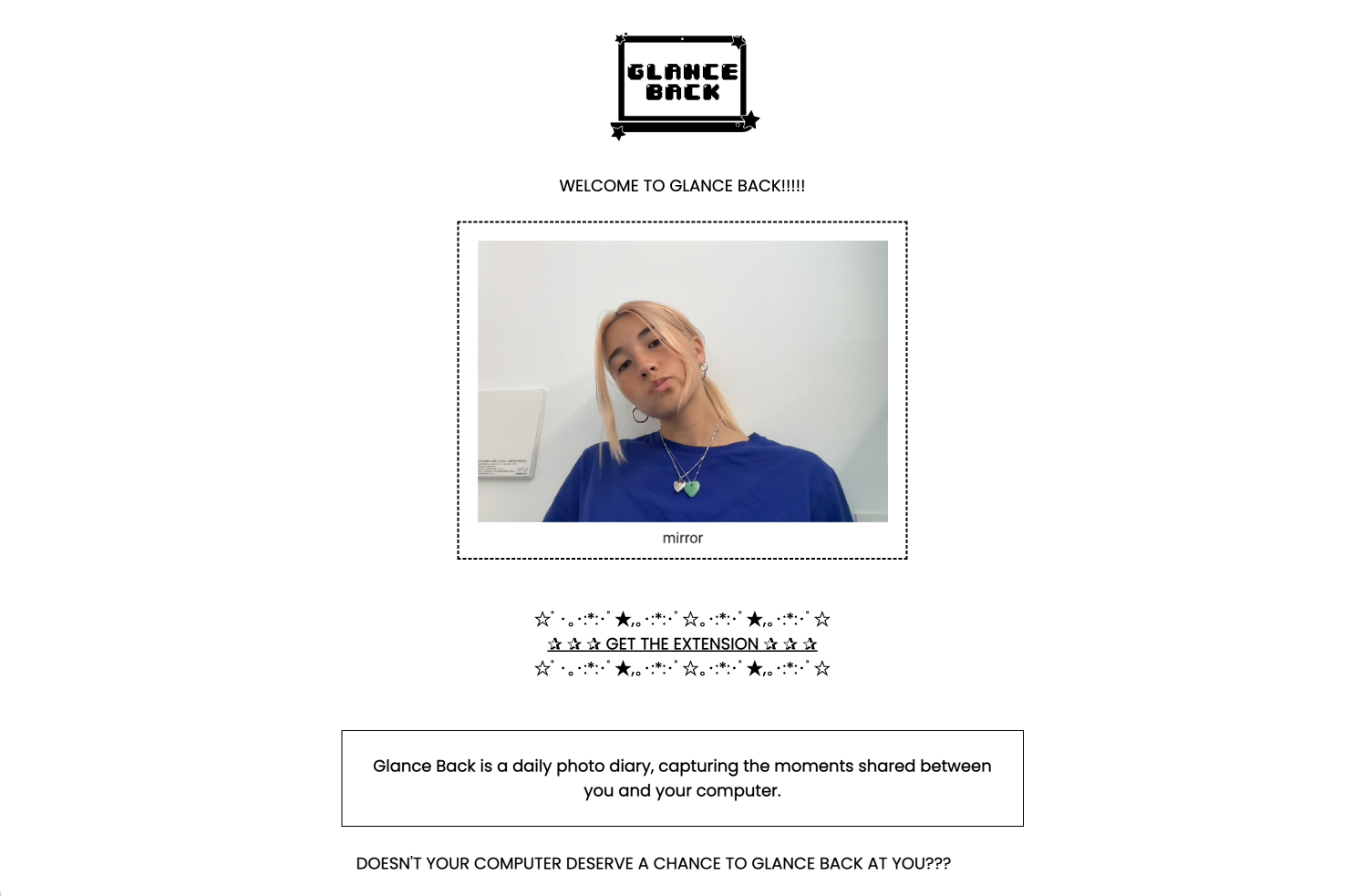
MM: Glance Back is an example of what you would now call generative art, art made in a predetermined system using an element of chance. (#generativeart) The extension takes a photo once a day at random and you don’t know exactly when it is going to happen. And there's this sense of liveness to it because in real time it will capture whatever you’re looking at on your computer and whatever you're thinking about at that moment.
I’ve been reflecting on my relationship to dance growing up, and noticed the value the form places on live performance and this sense of risk. I love building in some element of randomness to my work. I essentially give up some form of agency and allow the software to sort of execute the code as choreography or as a sort of live performance, and I don't know exactly what's going to happen.
I love building in some element of randomness to my work. I essentially give up some form of agency and allow the software to sort of execute the code as choreography or as a sort of live performance, and I don't know exactly what's going to happen.
AJ: BeReal came out shortly after Glance Back, which is similar in premise but happens on your phone as opposed to your desktop. As a result, the portrait of your life ends up looking completely different. So many of my Glance Backs would always just come on when I was in my UI/UX class because it was early in the day (it was 1pm) and often the first time I opened my laptop. If you looked at my archive through the entire fall semester, it just kind of looks like I lived in this lecture hall, whereas my BeReal at least had evidence that I sometimes went out and did things. So much of Glance Back felt to me like a portrait of my browser experience and I was wondering how the desktop space as a physical location figures into your work.
MM: I initially made Glance Back because I felt like I was spending so much time looking at my computer screen and I wanted something that acted as an antithesis to the way I represented my offline-life online. I also feel this panic about image creation that I have control over because so much of my memory is supplanted by the images that I have taken over the years. So much of what I can even think about the past two years comes to me in photos from my camera roll. So I have this feeling that my life needs to be preserved as a digital image, otherwise it's going to sort of evaporate into the ether.
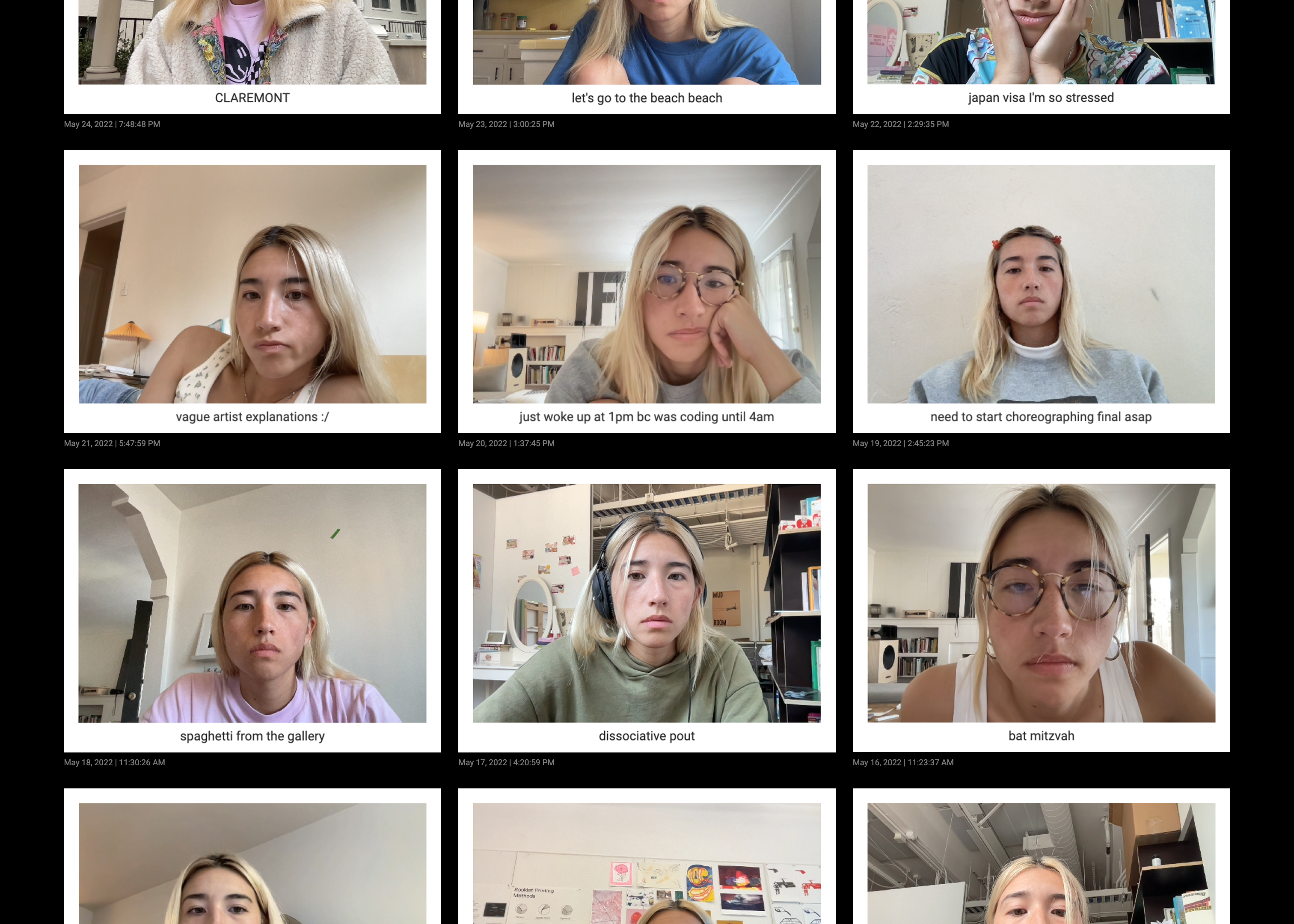
Glance Back is about this relationship that I have with my computer but also the longer that I've done it, it's become this archive of myself in these moments that are so small that I would never take out my phone and take a photo of them otherwise. Usually I'm so plugged into the portal of my desktop that I can't consciously conjure whatever I'm thinking about, but it's really nice to have an interruption that forces me to archive it. (#online)
AJ: I love that the caption element forces a kind of attentiveness that I otherwise lose just scrolling, typing, scrolling, tapping… I keep thinking about this article I read (or maybe it was a tweet…) that suggested when the filing cabinet was invented, people freaked out about how it would ruin everyone's memories because you would no longer be responsible for this information. I have a billion filing cabinets — aka windows open on my laptop — and I also have no recollection of anything at all.
Ah! Okay, I'm going to send you another Zoom because the timer at the top is freaking me out but I will see you very soon.
MM: Okay, bye!

JUST KIDDING !!!! NOT GOING ANYWHERE !!!! HERE AJ FORGOT TO RESTART THE RECORDING BUT SHE ASKS A LONG INSIGHTFUL QUESTION ABOUT PERFORMING RACE, TRAD-AESTHETICS AND MAYA MAN’S THE MODEL MINORITY IS A MYTH BILLBOARD (+ TOWEL). MAYA ANSWERED IN KIND:
MM: So I was super nervous about that piece. I was commissioned by For Freedoms to do a billboard of some sort for Asian American Pacific Islander Heritage Month in 2021. I'm half-Chinese but I always felt like I wasn't Chinese enough to really talk about that in my work. I was challenged by this idea of confronting my Asian American identity through my work, which is something that I hadn't really dealt with before in such a pointed, externalized way. But the more that I've thought about the type of work that I've made over the past two years, I've realized that a lot of these projects are about understanding the delta between how I feel about my own identity and what I see as representations of identity in the media, on the internet, and from other people in my life.
I grew up in a mostly white, conservative area, and I was always trying to understand what was the distance between me and this aspirational feminine identity, which was, at its core, about whiteness. Looking back at the magazines that I was reading and the celebrities that I looked up to, or even my Tumblr from 2011, I really can see that I had this desire to align myself with the white part of my identity in this intense but unconscious way. I was also thinking a lot about what kind of belief system is reinforced in America about Asian American identity. I wanted to understand why I felt so uncomfortable confronting it as an issue in my own life and why I felt invalidated in doing that. All the while, that phrase about the model minority myth kept kind of replaying in my head. #modelminority
I'm really into taking some familiar, American, maybe even lowbrow, cultural forms and then twisting them to serve whatever I'm interested in talking about. And that's really what happened with the billboard. I've never been particularly aesthetically driven as an artist. There are some people who are really talented at communicating visually, and that's never really been something that's come naturally to me. So I rely a lot on language, and with this project, paired that with a gospel billboard design to communicate this dissonance..
AJ: I also grew up in the suburbs reading Seventeen, reading Teen Vogue, and even Rookie, and I had this vision of femininity that was very much entrenched in whiteness. So much of the language and rhetoric was of optimization or self-improvement or self-surveillance, which almost assumes a possibility of interiority. I'm half-Korean and for so long I didn't understand why I wasn't able to articulate that side of me and, especially as a child, why I was so disdainful for that part of myself. Now, I think so much of what is imagined as East Asian femininity is a kind of stagnancy or objecthood that doesn't even have the interiority to participate in these fundamentally flawed systems. It's almost like a destination as opposed to a journey of womanhood.
Which feels like a lot of the things that you are interrogating in your work. There's also a couple reference points in Read it and Weep, an “infinitely performed text” with fragments collected from across the internet... You mention Jia Tolentino, Ocean Vuong, and Terry Nguyen's work and I see this kind of canon that is being formed. (#reading) And I think of you as one of the people who are creating this possibility of imperfect femininity that is open to Asian women, without romanticizing it, which I think is super awesome. That isn't much of a question but more of a thank you, it's cool that you do that.
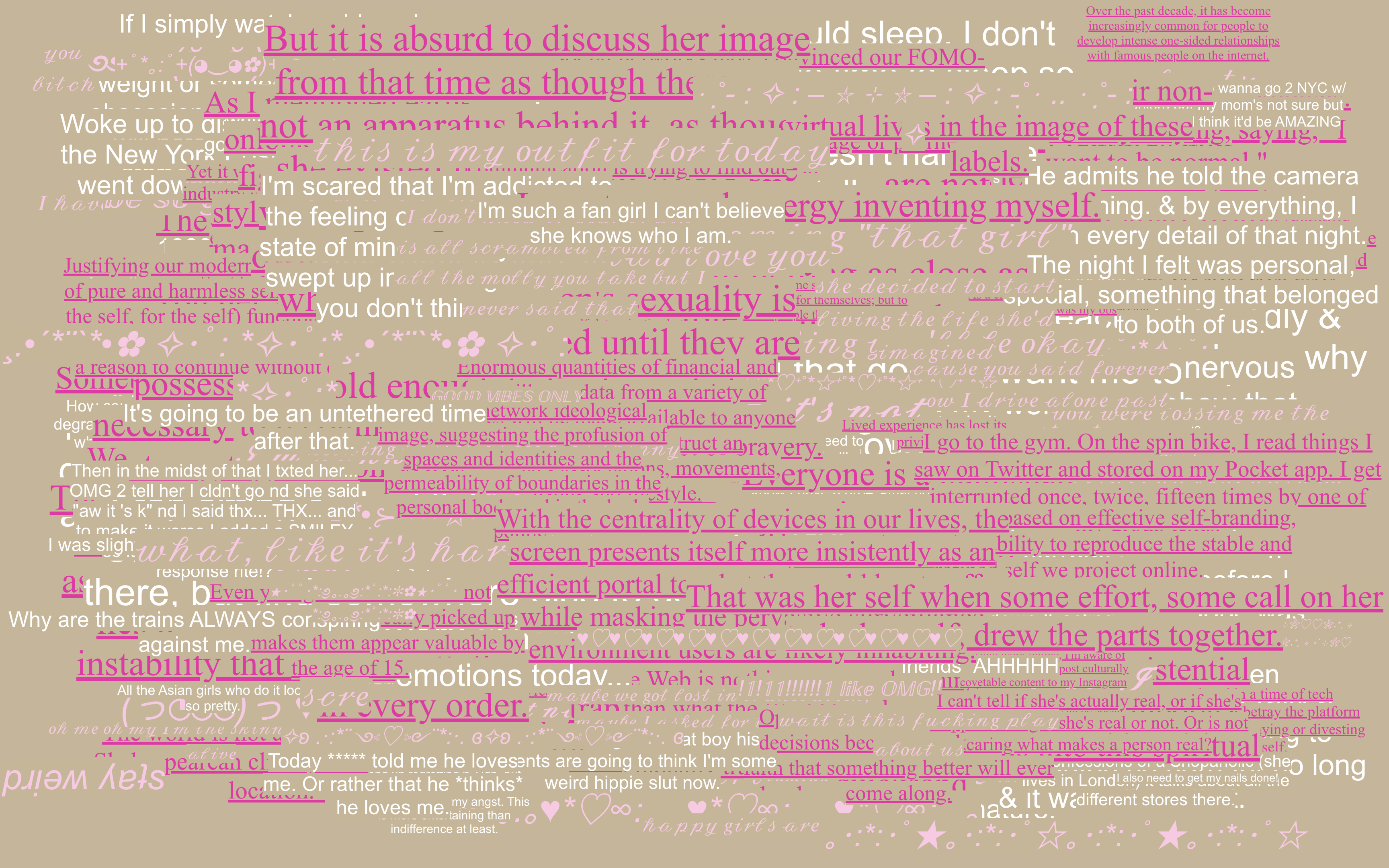
#girlhood
MM: That means so much to hear you say that. I think there's always been a little bit of a fear that if I tread too far in the direction of exploring Asian American identity, or Chinese American identity—which I already felt I didn't have the credibility to do—I worry about becoming an artist with that prefix. Lots of artists have talked about tokenization or thinking about themselves in this way. Still, I've been thinking about this idea of girlhood and who is "Girl" online, and then who is "Girl" online with a prefix in some way.
AJ: I was thinking about "Girl" online a lot with Read it and Weep because there's nothing in the text that is like, "this is specifically about being a girl."
MM: Right.
AJ: And yet all of the reference points were familiar. Obviously, so much of the process of consumption is aligned with girlhood. Part of that is about the consumption of products, this digital influx telling you to buy this to be like that. But also there's the consumption of information that obviously informs your beliefs and sense of self. I think Read it and Weep does a really incredible job of complicating consumption as entirely good or entirely bad. It's both a process of indoctrination and almost a method for becoming.
MM: Thank you. I struggle a lot in making this work that feels intentionally ambiguous. Because obviously, there's this capitalism is bad element to it. (#capital) So much of the experience of growing up as a young girl and being this intense target of marketing at all times, was so formative, and so dangerous. But at the same time, there's this perverse joy I have always found in it too.
#skincareI did a piece recently around Vogue's Beauty Secrets series, which I initially was interested in because I saw these videos as glorified advertisements for these products that are wrapped in this intimate person-in-a-bathroom-before-a-camera set up that's meant to make you feel comfortable and trust the person who's talking. But they're really just like pushing products on you! At the same time, I find enjoyment and comfort in watching them. And there is this sense of intimacy that feels valid and important to acknowledge when we talk about that kind of content. It's difficult to live in that ambiguous world. And it's nice to hear people can see the tension between these two opposite sides of the spectrum in my work. I'm not intending to glorify the media that I'm talking about at all, but I'm also not trying to condemn it and say, look at this, this is all bad, and capitalism is just awful. It would be easier to do that in some ways, but I feel really complicated about that. I like the work to live in this state that forces whoever's looking at it to form their own opinion and promote the literacy to be able to see the positive and negative pieces of it.
Do you know Tiqqun's Preliminary Materials for a Theory of the Young-Girl? (#gaze)
AJ: Nope.
MM: Okay, I'll send it to you. It takes a very urgent tone when condemning this idea of the young girl as a symbol of capitalism, essentially. Which is something that is happening in the world but is more complicated from the perspective of the young girl.
AJ: Yes!! On the one hand, I know it is bad to be marketed to at all times. On the other hand, I love Substack recommendations and I seek out lists. I was reading a Dirt newsletter recently that was just "sunscreens we like" and then this writer that I like (Sophie Kemp), had recommended a sunscreen from a Beauty Secrets video. She talked about how this one product didn't make her break out and I realized there is an intimacy to acknowledging the personal upkeep that we're forced into. In some ways, it feels reminiscent of gossip. (#gossip) It can be vapid and negative but I do believe that having a network of communication that takes into account the experience of femininity, or registers that yeah, I get marketed products so I want to take in ones from people that I trust —
MM: Oh, totally. I feel like we grew up in an age that's more and more secular and we don't have organized religion to sort of shape and co-create our identity and morals. So we look a lot to the internet for belief systems we see online and subcultures, but also to brands and products to understand like, Oh, am I the type of person to use this certain product? Or do I understand these small signifiers? Which is inherently tied to the intensified pace of consumption and production. But I think that has replaced what used to be fulfilled by organized religion. I also have been thinking a lot about gossip lately, too. Even though gossip usually has a negative connotation, there's also a long lineage of gossip allowing people to share informationg to protect one another.
AJ: Oh definitely. At some point in All About Love, bell hooks says gossip is important to protecting one another when we have information systems that require us to otherwise move up hierarchically towards dangerous power sources. Gossip allows us to move laterally towards each other.
IN NO POINT IN ALL ABOUT LOVE DOES BELL HOOKS SAY THIS.MM: Totally, totally.
AJ: All of this signage reminds me of the Tumblr or Polyvore-esque meme formatwhere people tried to assemble a person through all of these products. These objects have taken on a fetishistic quality, in the object-is-more-than-an-object sense. Our attention may be a reaction to contemporary godlessness and I can’t dismiss all of it because this identification feels like a very basic human need.
MM: We've also collectively become so much more literate and are so much more quick to categorize, which also ties into this desire to name certain aesthetics or categories of culture that we see online. There's such an overload of content that I receive every day that this desire to name things and understand if you identify with this specific "-core" or this specific starter pack or whatever is just a way to try to make sense of the barrage of content.
AJ: Oh it definitely makes sense as a way of making everything more digestible. If you can put a name to it, suddenly you can disregard, or at least contextualize, this previously free-form image. I also think the acceleration into micro-trends is really fascinating. In the broad fashion landscape—which I know very, very little about, living mostly in large T-shirts—it's so interesting how long we've been caught up in micro-trends accelerated by TikTok and being online. Yet, in real life, it is much more difficult to definitively state, "this is what people dress like right now." The disconnect between the overconsumption of digital style and the financial impossibility of actually keeping up with that creates a kind of look that exists almost entirely on Pinterest.
MM: Once in a while, I'll see someone when I'm out in the physical world who I feel is like completely embodying this singular online trend. But really it's the ability to collect and categorize all these images in our mind that gives us the sense that the trend even exists. I certainly have not collected enough data points, seeing how people dress, offline, to make any sort of categorical decision about what's trending.
AJ: Yeah, recently I was watching a vlog in which an influencer was talking about renting clothes. And I feel like a light bulb almost went off in my head. So much of her job is just peddling clothes that she doesn't even buy. The value comes from the image, as opposed to ownership.
MM: In many ways, influencers are just billboards and we’re just going back to the canvas for advertisement. It's so strange when you think about how many people aspire to become an influencer and receive all of these free PR gifts without acknowledging that you are performing the advertising labor. It's a really strange new tool for marketing.
AJ: I was thinking about the physical metaphors for these digital processes. (#quilt) Was your thesis presentation an actual—
MM: Yeah, I made a series of small quilts for my thesis. Sorry, I don't want to cut you off but I got super into this!
.png)
AJ: Haha no, go!
MM: Okay I don't have a sewing background, but I've been interested in patchwork and quilts as a metaphor for my experience of being on the internet for a long time. And a lot of my practice involves this process of collecting.
For example, Read it and Weep: collecting language that I've read online, collecting language from my own journals, or sounds from TikTok, that type of thing, and then collaging it all together in this sort of patchwork generative piece that asks whoever's looking at it to make connections between all these disparate forms of writing. And so I was thinking a lot about how a quilt essentially does that. It takes fabric from different sources and brings it together on a single plane to create a new object that makes sense of these different pieces together. On any sort of social media platform, you’re seeing posts from all these different people at once but then what's happening in your mind feels like the making of a quilt. The algorithm is feeding everything to me in this semi-determined, semi-randomized way and I am holding it all together, one thing after another, trying to make sense of it as a singular scroll experience. The scroll itself is a textile.
When I was making these quilts, I wanted to pull from different images that were all fed to me by an algorithm. In some sense, it's a reflection of what I personally am seeing online, not what everyone's algorithm looks like but however mine is finetuned. Then I print them on fabric and go through this manual process of slicing up the different imagery to create these sort of phrase-driven pieces through this process called improv quilting. Rather than having a preset pattern, I kind of like collage as I go with the piece in the fabric.
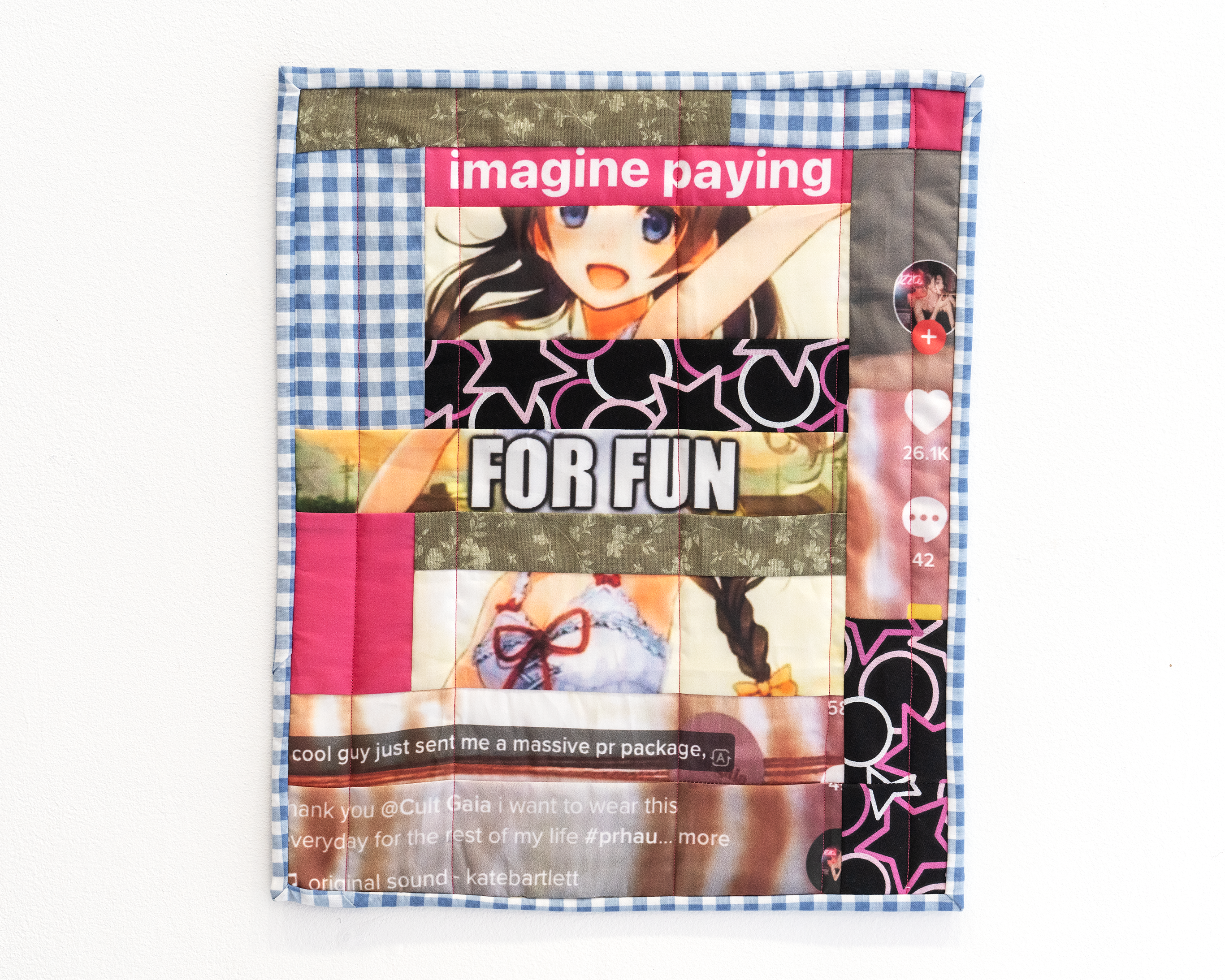
AJ:The materiality of it is also really interesting, because looking at the pictures online, obviously you can kind of tell that it's a quilt. But it's also so strange to realize, oh, that's a comment section that now exists in physical space. I never saw Secrets From a Girl physically, but have seen images online, and was thinking about those questions, however reversed. I was wondering, how do you go about physical exhibition, and if it is at all different from digital exhibition?
MM: A lot of my work is browser-based, and I really believe that if I send you the link and you watch it, like you open it in a text message, and you watch it in your browser, that's the work to me as much as when it's projected on a huge 4K screen in a gallery. Both are the true experience of viewing it to me.
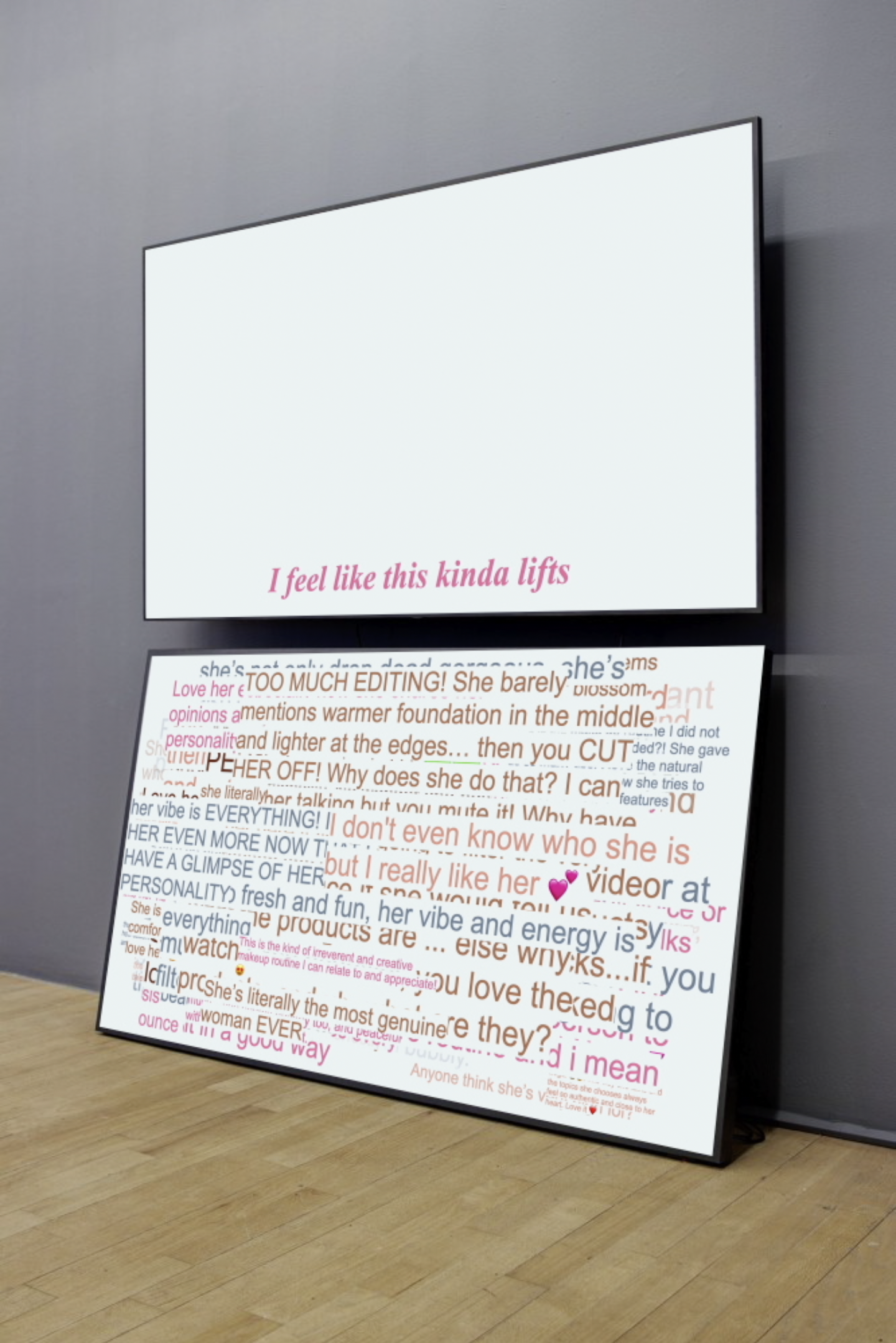
But what I love about showing work and physical space and putting together a show is having people spend time with the work and attend to it in a way that I feel it's just impossible to online because of the nature of being in the browser and having different tabs open. You're looking at one thing and then you're looking at the next. And so I love that it's a space for people to look at something, walk away, look at something else, come back, understand how what they previously looked at is informing what they're looking at now...
Making these physical works like the quilt or, I did a piece with a punching bag last year, I really love when I'm doing a show to be able to put the physical pieces next to the digital work and so people can understand the relationship between them in my mind, even though the materiality is so different. To me they're so connected in practice and so I also love being able to create that clear relationship between the pieces.
